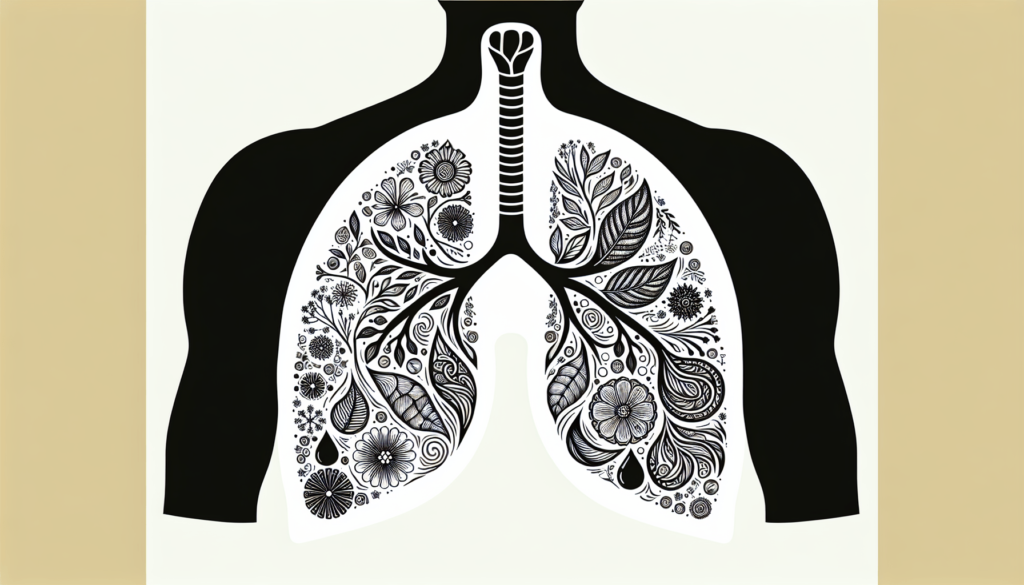So you’re interested in learning about the role of Traditional Chinese Medicine (TCM) in promoting lung health? Well, you’ve come to the right place! In this article, we’ll explore how TCM, with its holistic approach and centuries of wisdom, can play a crucial role in maintaining healthy lungs and treating respiratory conditions. From acupuncture and herbal remedies to lifestyle recommendations, TCM offers a unique perspective and treatment options for fostering optimal lung function. So let’s dive in and discover the fascinating world of TCM’s influence on lung health.

Introduction to Traditional Chinese Medicine (TCM)
Overview of TCM
Traditional Chinese Medicine (TCM) is an ancient healing system that has been practiced for thousands of years in China. It is a holistic approach to medicine that aims to restore balance and harmony within the body to promote overall health and wellbeing. TCM views the body as a interconnected system, where each organ and function relies on one another for optimal functioning.
Philosophy behind TCM
At the core of TCM is the belief that the body possesses an innate energy force called Qi (pronounced “chee”), which flows through channels known as meridians. When Qi is balanced and flowing smoothly, the body is in a state of health. However, imbalances in Qi can lead to various health issues. TCM aims to restore balance and harmony in the body by correcting these imbalances.
Key components of TCM
TCM involves several key components, including acupuncture, herbal medicine, diet and lifestyle recommendations, and various diagnostic techniques. These components work together to address the root cause of health issues and promote overall wellness.
Common practices in TCM
In addition to the use of acupuncture and herbal medicine, TCM also encompasses other practices such as cupping therapy, moxibustion, gua sha, and exercises like Qi gong and Tai chi. These practices are designed to promote the flow of Qi, stimulate healing, and enhance overall health and wellbeing.
Understanding Lung Health in TCM
Concept of lung health in TCM
In TCM, the lungs are considered one of the vital organs responsible for the respiratory system, but they have a broader significance beyond just breathing. The lungs are associated with the emotion of grief and are believed to control the flow of Qi throughout the body. Good lung health is essential for maintaining a strong immune system and overall wellbeing.
Role of lungs in TCM
According to TCM, the lungs play a crucial role in circulating Qi and ensuring the smooth flow of energy throughout the body. They are also responsible for dispersing Qi to other organs, nourishing the skin and hair, and controlling the opening and closing of pores.
Factors affecting lung health according to TCM
TCM believes that various factors can influence lung health. These include external factors such as seasonal changes, weather conditions, and environmental pollutants, as well as internal factors such as emotional stress, diet, lifestyle choices, and genetic predispositions. Imbalances in these factors can lead to lung-related disorders and affect overall health.
Diagnostic Techniques in TCM for Assessing Lung Health
Observation and inquiry
In TCM, the process of diagnosis begins with observing a patient’s physical appearance, behaviors, and listening to their concerns. Practitioners pay attention to signs such as facial complexion, voice quality, and breathing patterns to identify any potential lung health issues. They also inquire about symptoms, medical history, and lifestyle habits to gain a comprehensive understanding of the patient’s condition.
Pulse diagnosis
The pulse is an essential diagnostic tool in TCM. Practitioners assess the quality, rhythm, and strength of the pulse to determine the condition of the lung meridian and overall lung health. A weak or irregular pulse might indicate a deficiency or excess in lung Qi.
Tongue diagnosis
The tongue is considered a mirror of the body’s internal state in TCM, and practitioners rely on its appearance for diagnostic purposes. A pale or swollen tongue with a thin white coating may indicate lung Qi deficiency, while a red or dark-colored tongue with a thick coating may suggest heat or excess dampness in the lungs.
Other diagnostic methods
In addition to observation, inquiry, pulse diagnosis, and tongue diagnosis, TCM practitioners may also employ other diagnostic techniques such as palpation of specific acupuncture points, assessment of the patient’s odor, and analysis of urine or stool samples. These methods help provide a holistic understanding of the patient’s condition and guide the development of an effective treatment plan.
Herbs and Formulas for Lung Health in TCM
Commonly used herbs for lung health
TCM utilizes a wide range of herbs to support lung health. Some commonly used herbs include Astragalus, Ginseng, Mulberry Leaf, Licorice Root, and Schisandra. These herbs are believed to strengthen lung function, boost the immune system, and reduce inflammation.
Formulas for treating lung-related conditions
TCM practitioners often prescribe specific herbal formulas tailored to individual patients to address lung-related conditions. These formulas may include a combination of herbs targeting different aspects of lung health, such as clearing heat, resolving phlegm, tonifying lung Qi, or promoting lung Yin.
Functions of herbal medicines in TCM
Herbal medicines in TCM are believed to work by restoring balance and harmony within the body. They can help strengthen the respiratory system, reduce inflammation, expel pathogens, and enhance overall lung function. These herbs are often used in conjunction with other TCM modalities, such as acupuncture, for optimal therapeutic effects.
Acupuncture and Lung Health
Acupuncture points for promoting lung health
Acupuncture is a key component of TCM and involves the insertion of fine needles into specific points on the body to stimulate Qi flow and restore balance. There are several acupuncture points that are believed to promote lung health, including Lung 7 (Lie Que), Kidney 27 (Shu Fu), and Large Intestine 4 (He Gu). These points are chosen based on their ability to tonify lung Qi, resolve phlegm, and strengthen the immune system.
Benefits of acupuncture for respiratory conditions
Acupuncture has shown promising results in improving respiratory conditions such as asthma, bronchitis, and allergies. Studies have suggested that acupuncture can help reduce inflammation, relieve bronchial spasms, strengthen lung function, and alleviate symptoms such as coughing, wheezing, and shortness of breath.
Acupuncture techniques used in TCM
TCM utilizes various acupuncture techniques to address lung health issues. These techniques may include manual manipulation of the needles, electrical stimulation, or moxibustion (the application of heat to acupuncture points). The selection of techniques depends on the individual’s condition and the practitioner’s expertise.
Diet and Lifestyle Recommendations for Lung Health
Foods beneficial for lung health
In TCM, diet plays a crucial role in maintaining lung health. Foods that are believed to be beneficial for lung health include pears, white-fleshed fruits, garlic, ginger, honey, green leafy vegetables, seaweed, and mushrooms. These foods are thought to nourish lung Yin, clear heat, and support the immune system.
Foods to avoid for maintaining lung health
To maintain optimal lung health, TCM recommends avoiding foods that can exacerbate lung-related conditions, such as dairy products, greasy or fried foods, spicy foods, sugar, and excessive alcohol. These foods are believed to contribute to an excess of dampness or phlegm in the body and may hinder lung function.
Breathing exercises in TCM
TCM places great emphasis on the breath and its connection to lung health. Breathing exercises, such as deep abdominal breathing and diaphragmatic breathing, are frequently recommended to strengthen lung function, improve Qi circulation, and promote relaxation. These exercises can be practiced on their own or in conjunction with other TCM therapies.
Other lifestyle recommendations
In addition to diet and breathing exercises, TCM recommends certain lifestyle modifications to support lung health. These include avoiding exposure to pollutants, quitting smoking, practicing good hygiene, maintaining a balanced work-life schedule, getting regular exercise, and managing stress through techniques like meditation or Tai chi.
TCM Approaches to Common Lung Conditions
Asthma
In TCM, asthma is commonly associated with the disharmony of the lung and spleen meridians. Treatment may involve herbal formulas to tonify lung Qi and resolve phlegm, acupuncture to regulate Qi flow, and lifestyle recommendations to reduce triggers and strengthen the respiratory system.
Bronchitis
Bronchitis in TCM is often attributed to external pathogens impacting the lung meridian. Treatment may involve herbal medicines to clear heat and resolve phlegm, acupuncture to relieve inflammation and support the immune system, and lifestyle recommendations to avoid cold and damp environments.
Chronic obstructive pulmonary disease (COPD)
COPD is often categorized as a combination of chronic bronchitis and emphysema in TCM. Treatment may involve a combination of acupuncture, herbal medicines, and dietary modifications to reduce symptoms, improve lung function, and manage inflammation.
Pneumonia
Pneumonia is typically considered an acute infection in TCM and is often associated with external pathogens invading the lung meridian. Treatment involves herbal formulas to clear heat and resolve phlegm, acupuncture to boost the immune system and improve lung function, and supportive care measures.
Allergies
Allergies in TCM are related to an imbalanced immune response and often involve liver Qi stagnation. Treatment may include herbal formulas to regulate Qi flow and suppress allergic reactions, acupuncture to alleviate symptoms, and dietary recommendations to reduce dampness and strengthen the immune system.
Smoking-related lung diseases
TCM recognizes the detrimental effects of smoking on lung health. Treatment for smoking-related lung diseases may involve a combination of acupuncture, herbal medicines to clear toxins and resolve phlegm, and lifestyle recommendations to quit smoking and support lung recovery.
Complementary Therapies in TCM for Lung Health
Cupping therapy
Cupping therapy is a TCM technique that involves the placement of glass or plastic cups on the skin to create suction. It is believed to promote Qi and blood circulation, remove toxins, and relieve congestion in the lungs. Cupping therapy is often used as an adjunct to acupuncture or herbal treatments for lung-related conditions.
Moxibustion
Moxibustion is a TCM technique that involves burning dried mugwort herb near specific acupuncture points or meridians. The heat generated during moxibustion is believed to stimulate Qi flow, warm the meridians, and strengthen the immune system. Moxibustion can be used to support lung health by targeting specific points associated with lung function.
Gua sha
Gua sha is a TCM therapy that involves scraping the skin with a smooth-edged tool to promote blood circulation and eliminate toxins. Gua sha can be applied on the back and chest to relieve congestion and promote lung health. This therapy is often used in combination with other TCM modalities.
Qi gong and Tai chi
Qi gong and Tai chi are ancient Chinese exercises that combine breath control, meditation, and gentle movements to enhance Qi flow and promote overall health. These practices can be beneficial for strengthening lung function, improving respiratory capacity, reducing stress, and fostering a sense of relaxation and balance.
Research and Evidence on TCM for Lung Health
Studies investigating the efficacy of TCM for lung conditions
Scientific research has explored the effectiveness of TCM in treating various lung conditions. Studies have shown positive results in reducing symptoms and improving lung function in respiratory conditions such as asthma, chronic bronchitis, and COPD. However, further research is needed to establish a stronger evidence base.
Clinical trials and meta-analyses
Several clinical trials and meta-analyses have been conducted to evaluate the efficacy and safety of TCM treatments for lung conditions. These studies have shown promising results in terms of symptom improvement, reduction in exacerbations, and enhanced quality of life. However, the quality and design of these trials vary, and more rigorous studies are required.
Controversies and limitations in TCM research
While TCM has a long history of use, there are ongoing debates and challenges when it comes to research and evidence. Some limitations include the lack of rigorous clinical trials, difficulties in standardizing TCM treatments, and variations in the practitioner’s expertise. It is important to approach TCM research with an open but critical mind and consider it as a complementary approach to conventional medicine.
Integration of TCM with Conventional Medicine for Lung Health
Collaborative treatments
The integration of TCM with conventional medicine can offer a comprehensive and holistic approach to lung health. Collaborative treatments may involve coordinated care between TCM practitioners and Western healthcare providers. This collaboration allows for a combined approach that addresses both the underlying causes and symptoms of lung conditions.
Safety considerations
Safety is a crucial aspect when integrating TCM with conventional medicine. It is essential to consult with qualified TCM practitioners who have a solid understanding of both TCM and Western medicine. Communication between practitioners is vital, as some herbs may interact with Western medications or have contraindications in certain conditions.
Potential interactions between TCM and Western medications
It is important to be aware of potential interactions between TCM treatments and Western medications. Some herbs used in TCM may affect the metabolism or effectiveness of certain medications. Therefore, it is crucial to disclose all medications and treatments to both TCM practitioners and Western healthcare providers to ensure safe and effective integrative care.
In conclusion, Traditional Chinese Medicine (TCM) provides a unique and holistic approach to lung health. By focusing on restoring balance and harmony within the body, TCM aims to promote overall wellbeing and strengthen the respiratory system. Through various modalities such as acupuncture, herbal medicine, diet and lifestyle recommendations, and complementary therapies, TCM offers a comprehensive toolkit for maintaining lung health. However, further research and collaboration between TCM and conventional medicine are needed to establish a stronger evidence base and ensure safe and effective integration. By embracing the principles and practices of TCM, individuals can take a proactive approach to their lung health and enhance their overall quality of life.





